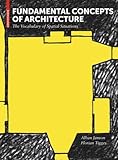Fundamental Concepts of Architecture : The Vocabulary of Spatial Situations / Alban Janson, Florian Tigges.
Material type: TextPublisher: Basel : Birkhäuser, [2014]Copyright date: ©2014Description: 1 online resource (396 p.)Content type:
TextPublisher: Basel : Birkhäuser, [2014]Copyright date: ©2014Description: 1 online resource (396 p.)Content type: - 9783034612616
- 9783034608923
- 720.3 23
- NA31 .J3613 2014
- NA31 .J36 2014
- online - DeGruyter
| Item type | Current library | Call number | URL | Status | Notes | Barcode | |
|---|---|---|---|---|---|---|---|
 eBook
eBook
|
Biblioteca "Angelicum" Pont. Univ. S.Tommaso d'Aquino Nuvola online | online - DeGruyter (Browse shelf(Opens below)) | Online access | Not for loan (Accesso limitato) | Accesso per gli utenti autorizzati / Access for authorized users | (dgr)9783034608923 |
Browsing Biblioteca "Angelicum" Pont. Univ. S.Tommaso d'Aquino shelves, Shelving location: Nuvola online Close shelf browser (Hides shelf browser)

|

|

|

|

|

|

|
||
| online - DeGruyter A Century of Austrian Design : 1900-2005 / | online - DeGruyter Limited Edition : Prototypes, One-Offs and Design Art Furniture / | online - DeGruyter Limited Edition : Prototypen, Unikate und Design-Art-Möbel / | online - DeGruyter Fundamental Concepts of Architecture : The Vocabulary of Spatial Situations / | online - DeGruyter Small Town Sustainability : Economic, Social, and Environmental Innovation / | online - DeGruyter Kleinstädte und Nachhaltigkeit : Konzepte für Wirtschaft, Umwelt und soziales Leben / | online - DeGruyter Bauen in China : Handbuch für Architekten und Ingenieure / |
Frontmatter -- Introduction -- Terms -- Access - Axis -- Balance - Building -- Cabinet - Cupola -- Dance - Dwelling -- Elevator - Extension -- Fabric - Furniture -- Gallery - Guidance -- Hall - House -- Idea - Invitation character -- Joining - Joint -- Kinaesthesia - Kitchen -- Lamp - Loggia -- Mass/massiveness - Movement -- Narrowness - Noise -- Odour - Outdoor space -- Panel - Purpose -- Quarter -- Radiality - Row -- Sacral - Synaesthesia -- Table - Typology -- Urban design - Use -- Vaulting - Visual target -- Walking - Workplace -- Zoning -- Bibliography -- Illustrations -- Backmatter
restricted access online access with authorization star
http://purl.org/coar/access_right/c_16ec
Architecture is an experience – with the intellect and with all our senses, in motion, and in use. But in order to actually discuss and assess it with relevance, a clarification of terms is essential in order to avoid the vagueness that often prevails when talking about architecture.This dictionary provides a vocabulary that allows the architecture discourse to go beyond the declaration of constructive relationships or the description of architectonic forms in familiar terms like “roof,” “base,” “wall,” and “axis” or “proportion”. The point is to describe the experience of architecture: how exactly does it contribute to the experience of a situation? For instance, the staging of an entrance situation, or the layout and visitor routes through a museum.From “context,” through “guidance,” “readability,” “patina,” “spatial structure,” “symmetry” and “tectonics,” to “width” (and “narrowness”) or “window,” the most important terms in architectural language are explained precisely and in detail.
Wörterbuch der architektonischen Erfahrung – Wie wir Räume erleben Architektur wird erlebt – mit Intellekt und mit allen Sinnen, in der Bewegung und im Gebrauch. Doch um darüber tatsächlich zutreffend zu reden und zu urteilen, ist eine Klärung der Begriffe nötig, wenn die Schwammigkeit vermieden werden soll, die auf diesem Gebiet oft vorherrscht.Dieses Wörterbuch gibt ein Vokabular an die Hand, das ein Sprechen über Architektur jenseits der Erklärung konstruktiver Zusammenhänge oder der Beschreibung architektonischer Formen ermöglicht, unter der Verwendung geläufiger Begriffe wie „Dach“, „Sockel“, „Wand“ und „Achse“ oder „Proportion“. Es geht darum, das Erleben von Architektur zu beschreiben: Wie trägt sie zum Erleben einer Situation bei? Etwa in der Inszenierung einer Eingangssituation oder mit der Wegeführung durch ein Museum.Von A bis Z, von „Ablesbarkeit“ über „Fenster“, „Kontext“, „Orientierung“, „Patina“, „Raumgefüge“, „Symmetrie“ und „Tektonik“ bis hin zu „Weite“ (und „Enge“) oder „Zentrum“ werden die wichtigsten Begriffe der Architektursprache differenziert und vielschichtig erklärt.Präzise Handskizzen des Autors illustrieren den Text und bilden ein visuelles Gegengewicht zur Erläuterung von insgesamt 139 Stichworten.
Mode of access: Internet via World Wide Web.
In English.
Description based on online resource; title from PDF title page (publisher's Web site, viewed 30. Aug 2021)


